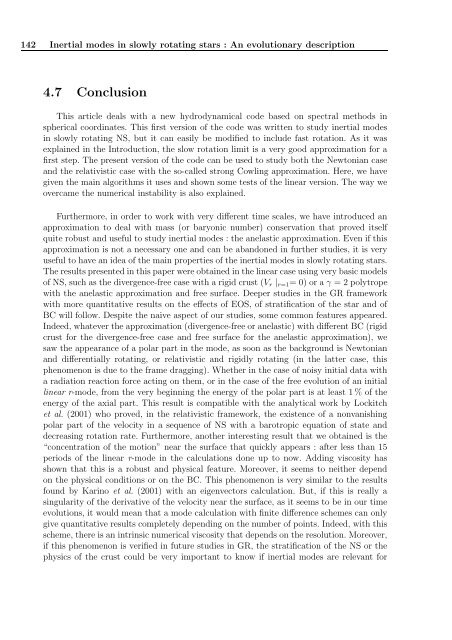Ecole doctorale de Physique de la région Parisienne (ED107)
Ecole doctorale de Physique de la région Parisienne (ED107)
Ecole doctorale de Physique de la région Parisienne (ED107)
Create successful ePaper yourself
Turn your PDF publications into a flip-book with our unique Google optimized e-Paper software.
142 Inertial mo<strong>de</strong>s in slowly rotating stars : An evolutionary <strong>de</strong>scription<br />
4.7 Conclusion<br />
This article <strong>de</strong>als with a new hydrodynamical co<strong>de</strong> based on spectral methods in<br />
spherical coordinates. This first version of the co<strong>de</strong> was written to study inertial mo<strong>de</strong>s<br />
in slowly rotating NS, but it can easily be modified to inclu<strong>de</strong> fast rotation. As it was<br />
exp<strong>la</strong>ined in the Introduction, the slow rotation limit is a very good approximation for a<br />
first step. The present version of the co<strong>de</strong> can be used to study both the Newtonian case<br />
and the re<strong>la</strong>tivistic case with the so-called strong Cowling approximation. Here, we have<br />
given the main algorithms it uses and shown some tests of the linear version. The way we<br />
overcame the numerical instability is also exp<strong>la</strong>ined.<br />
Furthermore, in or<strong>de</strong>r to work with very different time scales, we have introduced an<br />
approximation to <strong>de</strong>al with mass (or baryonic number) conservation that proved itself<br />
quite robust and useful to study inertial mo<strong>de</strong>s : the ane<strong>la</strong>stic approximation. Even if this<br />
approximation is not a necessary one and can be abandoned in further studies, it is very<br />
useful to have an i<strong>de</strong>a of the main properties of the inertial mo<strong>de</strong>s in slowly rotating stars.<br />
The results presented in this paper were obtained in the linear case using very basic mo<strong>de</strong>ls<br />
of NS, such as the divergence-free case with a rigid crust (Vr |r=1= 0) or a γ = 2 polytrope<br />
with the ane<strong>la</strong>stic approximation and free surface. Deeper studies in the GR framework<br />
with more quantitative results on the effects of EOS, of stratification of the star and of<br />
BC will follow. Despite the naive aspect of our studies, some common features appeared.<br />
In<strong>de</strong>ed, whatever the approximation (divergence-free or ane<strong>la</strong>stic) with different BC (rigid<br />
crust for the divergence-free case and free surface for the ane<strong>la</strong>stic approximation), we<br />
saw the appearance of a po<strong>la</strong>r part in the mo<strong>de</strong>, as soon as the background is Newtonian<br />
and differentially rotating, or re<strong>la</strong>tivistic and rigidly rotating (in the <strong>la</strong>tter case, this<br />
phenomenon is due to the frame dragging). Whether in the case of noisy initial data with<br />
a radiation reaction force acting on them, or in the case of the free evolution of an initial<br />
linear r-mo<strong>de</strong>, from the very beginning the energy of the po<strong>la</strong>r part is at least 1 % of the<br />
energy of the axial part. This result is compatible with the analytical work by Lockitch<br />
et al. (2001) who proved, in the re<strong>la</strong>tivistic framework, the existence of a nonvanishing<br />
po<strong>la</strong>r part of the velocity in a sequence of NS with a barotropic equation of state and<br />
<strong>de</strong>creasing rotation rate. Furthermore, another interesting result that we obtained is the<br />
“concentration of the motion” near the surface that quickly appears : after less than 15<br />
periods of the linear r-mo<strong>de</strong> in the calcu<strong>la</strong>tions done up to now. Adding viscosity has<br />
shown that this is a robust and physical feature. Moreover, it seems to neither <strong>de</strong>pend<br />
on the physical conditions or on the BC. This phenomenon is very simi<strong>la</strong>r to the results<br />
found by Karino et al. (2001) with an eigenvectors calcu<strong>la</strong>tion. But, if this is really a<br />
singu<strong>la</strong>rity of the <strong>de</strong>rivative of the velocity near the surface, as it seems to be in our time<br />
evolutions, it would mean that a mo<strong>de</strong> calcu<strong>la</strong>tion with finite difference schemes can only<br />
give quantitative results completely <strong>de</strong>pending on the number of points. In<strong>de</strong>ed, with this<br />
scheme, there is an intrinsic numerical viscosity that <strong>de</strong>pends on the resolution. Moreover,<br />
if this phenomenon is verified in future studies in GR, the stratification of the NS or the<br />
physics of the crust could be very important to know if inertial mo<strong>de</strong>s are relevant for
















